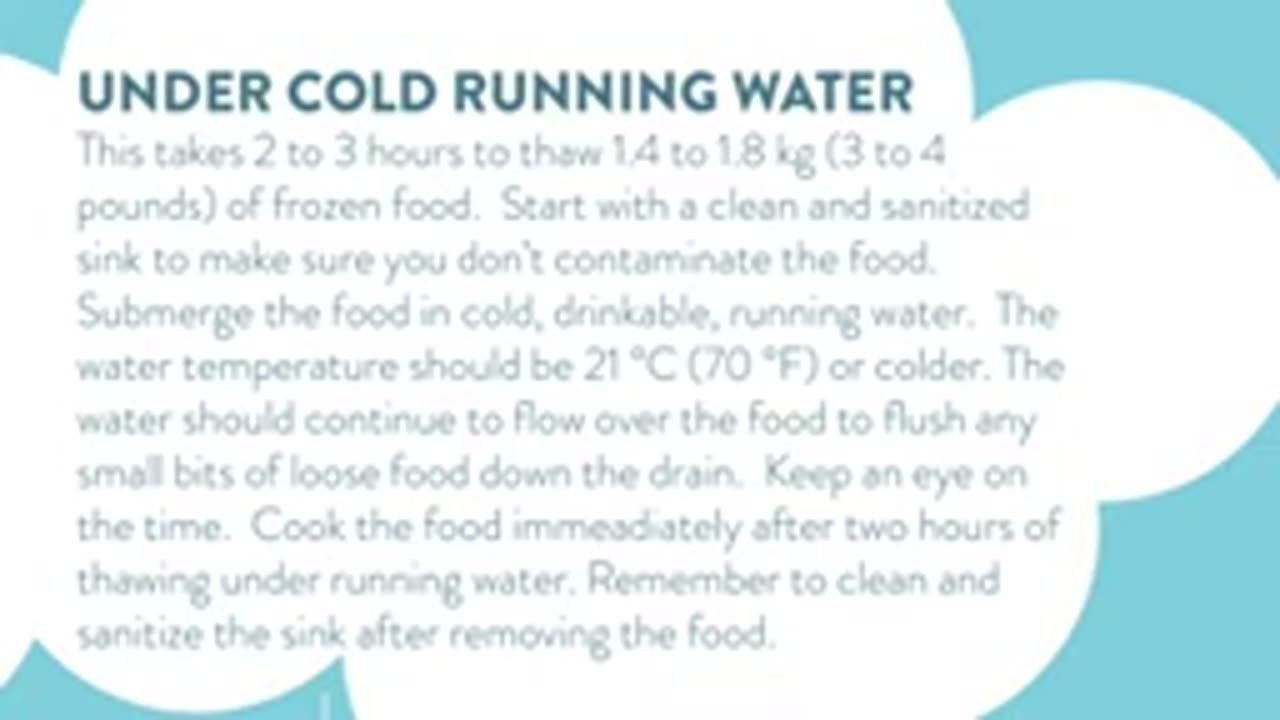Premium Only Content

Your Essential Guide to Thawing Food Safely
### **Your Essential Guide to Thawing Food Safely**
Thawing food properly is crucial for preventing the growth of harmful bacteria and ensuring that food remains safe to eat. Improper thawing can lead to foodborne illnesses, so it’s important to follow safe practices to keep your food safe. Here’s your essential guide to thawing food safely:
---
### **1. The Dangers of Thawing Food Improperly**
- **Why**: Thawing food improperly allows it to stay in the "danger zone" (between **5°C and 60°C** or **41°F and 140°F**), which promotes bacterial growth. This is especially risky for perishable foods like meat, poultry, seafood, and dairy.
- **How**: Avoid thawing food at room temperature (e.g., on the counter), as this can result in uneven thawing where the outer layers warm up too quickly, allowing bacteria to multiply before the inside of the food has thawed.
---
### **2. The Safe Methods of Thawing Food**
#### **a. Refrigerator Thawing**
- **Why**: Thawing food in the refrigerator keeps it at a safe, consistent temperature of **4°C (40°F)** or below, which prevents bacteria from growing.
- **How**:
- **Plan ahead**: This method takes time, so allow **12-24 hours** (depending on the size and type of food) for the food to thaw completely.
- **Keep the fridge temperature below 4°C**: Always use a refrigerator thermometer to ensure it is cooling properly.
- **Keep raw meats separate**: Store meat and poultry on the bottom shelf to prevent juices from contaminating other foods.
#### **b. Cold Water Thawing**
- **Why**: This method is faster than refrigerator thawing but still keeps the food out of the danger zone.
- **How**:
- **Use a leak-proof bag**: Place food in a sealed, leak-proof plastic bag to prevent water from touching the food, which could lead to contamination.
- **Submerge in cold water**: Place the bagged food in a container of **cold water** (not warm or hot, as this can cause bacteria growth).
- **Change the water every 30 minutes**: To ensure the water stays cold enough to safely thaw the food.
- **Cook immediately**: After thawing with this method, cook the food right away.
#### **c. Microwave Thawing**
- **Why**: The microwave is the quickest method of thawing food but requires careful monitoring to ensure the food doesn’t begin cooking in some areas.
- **How**:
- **Use the defrost setting**: Most microwaves have a specific defrost function designed for safely thawing food.
- **Monitor closely**: Rotate or stir the food as it defrosts to ensure even thawing. Stop the process if any part of the food begins cooking.
- **Cook immediately**: Once thawed, microwave-thawed food should be cooked immediately, as parts of it may have started cooking, making it susceptible to bacteria growth.
---
### **3. Do Not Thaw Food in Hot Water or at Room Temperature**
- **Why**: Thawing food at room temperature or in hot water increases the risk of bacterial growth. At room temperature, the outside of the food can enter the danger zone (between **5°C and 60°C**) before the inside has thawed, allowing bacteria to multiply rapidly.
- **How**: Always avoid thawing food on countertops, in the sink, or using hot water. These methods may lead to unsafe food temperatures and put you at risk for foodborne illness.
---
### **4. Thawing Frozen Meat, Poultry, and Seafood**
- **Why**: Meat, poultry, and seafood are highly perishable, and proper thawing ensures food safety.
- **How**:
- **Refrigerator thawing** is the safest method for all types of meat and seafood.
- **Cold water thawing** can be used for quicker thawing, especially with poultry or fish. Make sure the water is cold and that the food is in a leak-proof bag to avoid cross-contamination.
- **Microwave thawing** is ideal for when you're in a hurry. However, it’s important to cook the food immediately after microwave thawing, as parts of it may begin cooking.
---
### **5. Can You Refreeze Thawed Food?**
- **Why**: Refreezing thawed food is a common concern, especially when it comes to quality and safety.
- **How**:
- **If thawed in the refrigerator**: Food that has thawed in the fridge and has remained at **4°C (40°F)** or below can be safely refrozen, although the texture and quality may degrade.
- **If thawed in cold water or microwave**: Foods thawed with these methods should **not be refrozen** unless they were cooked immediately after thawing.
- **Do not refreeze if food is left out too long**: If thawed food has been at room temperature for more than **2 hours** (or **1 hour** in hot weather), discard it. Refreezing or consuming it could lead to foodborne illness.
---
### **6. Best Practices for Thawing Prepared Foods**
- **Why**: Prepared or cooked foods also need careful thawing to preserve quality and safety.
- **How**:
- **Refrigerator thawing**: This is the safest way to thaw cooked or prepared foods. It keeps the food at a safe temperature and preserves its texture and flavor.
- **Cold water thawing**: If you're in a rush, use cold water thawing in a sealed bag. This is especially useful for leftovers like casseroles, stews, or soups.
- **Microwave thawing**: You can use the microwave to quickly thaw prepared meals but be sure to cook them immediately after thawing.
---
### **7. Tips for Thawing Frozen Vegetables and Fruits**
- **Why**: Vegetables and fruits may be more delicate than meats, and thawing them improperly can affect their texture and quality.
- **How**:
- **Frozen vegetables**: They can be cooked directly from frozen, without the need for thawing. If you prefer to thaw them first, refrigerator thawing or microwave thawing is best.
- **Frozen fruits**: Thaw fruit in the refrigerator or microwave to maintain texture. Some fruits, like berries, can be eaten directly from the freezer or used in smoothies, as they don’t require thawing.
---
### **8. Thawing Food for Safety and Quality**
- **Why**: Thawing food the right way not only keeps it safe but also helps preserve its flavor, texture, and nutritional value.
- **How**:
- **Thaw before cooking**: For best results, allow frozen food to thaw before cooking, unless specified otherwise in a recipe. This ensures that food cooks evenly.
- **Check for signs of spoilage**: After thawing, check for any signs of spoilage, such as unusual smells, color changes, or slimy textures. Discard anything that looks or smells off.
---
### **9. Thawing and Cooking Times**
- **Why**: Knowing how long it takes to thaw food and how it affects cooking times is essential for meal planning.
- **How**:
- **Meat and poultry**: Thaw in the refrigerator for 12-24 hours, depending on the size. Larger items like whole turkeys can take several days to thaw.
- **Smaller cuts (steaks, chops)**: Can be thawed more quickly, in 4-6 hours if using cold water or in the microwave.
- **Fish**: Thaw in the refrigerator for 6-12 hours. Fish can also be cooked from frozen, but it will require a longer cooking time.
---
### **10. Thawing Large Cuts of Meat (e.g., Whole Turkey, Roast)**
- **Why**: Large cuts of meat take longer to thaw, and improper thawing can result in unsafe bacteria growth.
- **How**:
- **Plan ahead**: Thaw large cuts of meat, like a whole turkey, in the refrigerator **at least 24 hours per 2-2.5 kg (4-5 pounds)**.
- **Cold water thawing for large cuts**: If you need to thaw a large roast quickly, cold water thawing is an option. Make sure to submerge the meat in its sealed packaging and change the water every 30 minutes.
---
### **Conclusion: Thawing Safely is Key to Food Safety**
By following safe thawing methods, you can protect yourself and others from foodborne illnesses while maintaining the quality and flavor of your meals. Always remember:
- Thaw in the refrigerator for the safest option.
- Avoid room temperature thawing and always cook food immediately after using cold water or microwave thawing methods.
- Never refreeze food that has been left at room temperature for too long.
Would you like further tips on specific foods or how to organize your kitchen for safe thawing?
-
 8:50:58
8:50:58
Right Side Broadcasting Network
1 day ago🎅 LIVE: Tracking Santa on Christmas Eve 2024 NORAD Santa Tracker 🎅
302K41 -
 2:48
2:48
Steven Crowder
1 day agoCROWDER CLASSICS: What’s This? | Nightmare Before Kwanzaa (Nightmare Before Christmas Parody)
292K12 -
 33:49
33:49
Quite Frankly
23 hours agoThe Christmas Eve Midnight Telethon
102K22 -
 2:12:46
2:12:46
Price of Reason
22 hours agoAmber Heard BACKS Blake Lively Lawsuit Against Justin Baldoni! Is Disney CEO Bob Iger in TROUBLE?
56.9K23 -
 1:01:17
1:01:17
The StoneZONE with Roger Stone
17 hours agoChristmas Edition: Why the Panama Canal is Part of the America First Agenda | The StoneZONE
127K47 -
 18:12:15
18:12:15
LFA TV
1 day agoLFA TV CHRISTMAS EVE REPLAY
142K18 -
 13:32
13:32
Scammer Payback
18 hours agoChanging the Scammer's Desktop Background to his Location
12.2K3 -
 4:21
4:21
BIG NEM
20 hours agoNikola Tesla's Secret to Cultivating Creativity & Genius
8.76K1 -
 15:03
15:03
The Anthony Rogers Show
1 day agoAnthony Rogers - Live at Cusumano's Pizza (Upstairs)
6.96K1 -
 4:33:48
4:33:48
tacetmort3m
1 day ago🔴 LIVE - THE ZONE KEEPS PULLING ME BACK - STALKER 2 - PART 15
73.2K13